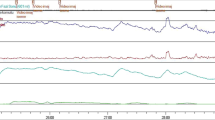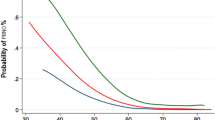Abstract
Primary bladder neck obstruction (PBNO) is a rare condition of the lower urinary tract seen in young and middle-aged patients. The true prevalence of this entity is unknown; however, it has been reported in 5–11 % of young women and 28–54 % of young men with lower urinary tract symptoms (LUTS). The diagnosis of PBNO requires a high index of suspicion and an experienced clinician due to the variety of presenting urinary symptoms, and often a much delayed presentation, which frequently is not reported by patients, and often misdiagnosed by clinicians. Videourodynamics (VUDS) will greatly assist in making the diagnosis. Observation, medical therapy, and surgical therapy are the treatment options with variable success rates. This detailed review focuses on history, presentation, diagnosis, and management of PBNO in both men and women.

Similar content being viewed by others
References
Papers of particular interest, published recently, have been highlighted as: • Of importance ••Of major importance
Marion G, Weijtlandt JA. Surgery of the neck of the bladder. Br J Urol. 1933;5(4):351–80.
Nanson EM. Marion’s disease or bladder neck stenosis. Aust N Z J Surg. 1951;20(3):215–23.
Woodside JR. Urodynamic evaluation of dysfunctional bladder neck obstruction in men. J Urol. 1980;124(5):673–7.
Awad SA, Downie JW, Lywood DW, Young RA, Jarzylo SV. Sympathetic activity in the proximal urethra in patients with urinary obstruction. J Urol. 1976;115(5):545–7.
Bates CP, Arnold EP, Griffiths DJ. The nature of the abnormality in bladder neck obstruction. Br J Urol. 1975;47(6):651–6.
Leadbetter Jr GW, Leadbetter WF. Diagnosis and treatment of congenital bladder-neck obstruction in children. N Engl J Med. 1959;260(13):633–7.
Smith DR. Critique on the concept of vesical neck obstruction in children. JAMA. 1969;207(9):1686–92.
Farrar DJ, Osborne JL, Stephenson TP, Whiteside CG, Weir J, Berry J, et al. A urodynamic view of bladder outflow obstruction in the female: factors influencing the results of treatment. Br J Urol. 1975;47(7):815–22.
Diokno AC, Hollander JB, Bennett CJ. Bladder neck obstruction in women: a real entity. J Urol. 1984;132(2):294–8. This was the first description of PBNO in women.
Toh KL, Ng CK. Urodynamic studies in the evaluation of young men presenting with lower urinary tract symptoms. Int J Urol. 2006;13(5):520–3.
Kaplan SA, Te AE, Jacobs BZ. Urodynamic evidence of vesical neck obstruction in men with misdiagnosed chronic nonbacterial prostatitis and the therapeutic role of endoscopic incision of the bladder neck. J Urol. 1994;152(6 Pt 1):2063–5. This article higlights that PBNO is often misdiagnosed as other diagnoses.
Nitti VW, Lefkowitz G, Ficazzola M, Dixon CM. Lower urinary tract symptoms in young men: videourodynamic findings and correlation with noninvasive measures. J Urol. 2002;168(1):135–8.
Yang SS, Wang CC, Hsieh CH, Chen YT. alpha1-Adrenergic blockers in young men with primary bladder neck obstruction. J Urol. 2002;168(2):571–4.
Karami H, Valipour R, Lotfi B, Mokhtarpour H, Razi A. Urodynamic findings in young men with chronic lower urinary tract symptoms. Neurourol Urodyn. 2011;30(8):1580–5.
Jamzadeh AE, Xie D, Laudano M, Seklehner S, Elterman DS, Shtromvaser L, et al. Urodynamic characterization of lower urinary tract symptoms in men less than 40 years of age. World J Urol. 2014;32(2):469–73.
Groutz A, Blaivas JG, Chaikin DC. Bladder outlet obstruction in women: definition and characteristics. Neurourol Urodyn. 2000;19(3):213–20.
Nitti VW, Tu LM, Gitlin J. Diagnosing bladder outlet obstruction in women. J Urol. 1999;161(5):1535–40.
Akikwala TV, Fleischman N, Nitti VW. Comparison of diagnostic criteria for female bladder outlet obstruction. J Urol. 2006;176(5):2093–7. This article compares various criteria of female BOO.
Kuo HC. Videourodynamic characteristics and lower urinary tract symptoms of female bladder outlet obstruction. Urology. 2005;66(5):1005–9.
Blaivas JG, Groutz A. Bladder outlet obstruction nomogram for women with lower urinary tract symptomatology. Neurourol Urodyn. 2000;19(5):553–64.
Jamzadeh AE, Xie D, Laudano MA, Elterman DS, Seklehner S, Shtromvaser L, et al. Urodynamic characterization of lower urinary tract symptoms in women less than 40 years of age. Can J Urol. 2014;21(5):7460–4.
Badenoch AW. Congenital obstruction at the bladder neck. Ann R Coll Surg Engl. 1949;4(5):295–307.
Turner-Warwick R, Whiteside CG, Worth PH, Milroy EJ, Bates CP. A urodynamic view of the clinical problems associated with bladder neck dysfunction and its treatment by endoscopic incision and trans-trigonal posterior prostatectomy. Br J Urol. 1973;45(1):44–59.
Yalla SV, Gabilondo FB, Blunt KJ, Fam BA, Castello A, Kaufman JM. Functional striated sphincter component at the bladder neck: clinical implications. J Urol. 1977;118(3):408–11.
Yalla SV, Blute RD, Snyder H, Yap W, Fraser L, Friedman E. Isolated bladder neck obstruction of undetermined etiology (primary) in adult male: recognition and management. Urology. 1981;17(1):99–108.
Yalla SV, Waters WB, Snyder H, Varady S, Blute R. Urodynamic localization of isolated bladder neck obstruction in men: studies with micturitional vesicourethral static pressure profile. J Urol. 1981;125(5):677–84.
Crowe R, Noble J, Robson T, Soediono P, Milroy EJ, Burnstock G. An increase of neuropeptide Y but not nitric oxide synthase-immunoreactive nerves in the bladder neck from male patients with bladder neck dyssynergia. J Urol. 1995;154(3):1231–6.
Margulis V, Lin VK, Wang S-Y, Tang J, Zimmern PE. Characterization of primary bladder neck obstruction: immunohistochemical and gene expression analysis. Curr Urol. 2007;1(2):95–9.
Trockman BA, Gerspach J, Dmochowski R, Haab F, Zimmern PE, Leach GE. Primary bladder neck obstruction: urodynamic findings and treatment results in 36 men. J Urol. 1996;156(4):1418–20.
Suri A, Srivastava A, Singh KJ, Dubey D, Mandhani A, Kapoor R, et al. Endoscopic incision for functional bladder neck obstruction in men: long-term outcome. Urology. 2005;66(2):323–6.
Huckabay C, Nitti VW. Diagnosis and treatment of primary bladder neck obstruction in men. Curr Urol Rep. 2005;6(4):271–5.
Norlen LJ, Blaivas JG. Unsuspected proximal urethral obstruction in young and middle-aged men. J Urol. 1986;135(5):972–6.
Hruz P, Danuser H, Studer UE, Hochreiter WW. Non-inflammatory chronic pelvic pain syndrome can be caused by bladder neck hypertrophy. Eur Urol. 2003;44(1):106–10. discussion 110.
Axelrod SL, Blaivas JG. Bladder neck obstruction in women. J Urol. 1987;137(3):497–9.
Nitti VW. Primary bladder neck obstruction in men and women. Rev Urol. 2005;7 Suppl 8:S12–7.
Delaere KP, Debruyne FM, Moonen WA. Bladder neck incision in the female: a hazardous procedure? Br J Urol. 1983;55(3):283–6.
Gronbaek K, Struckmann JR, Frimodt-Moller C. The treatment of female bladder neck dysfunction. Scand J Urol Nephrol. 1992;26(2):113–8.
Kumar A, Mandhani A, Gogoi S, Srivastava A. Management of functional bladder neck obstruction in women: use of alpha-blockers and pediatric resectoscope for bladder neck incision. J Urol. 1999;162(6):2061–5.
Bates CP, Whiteside CG, Turner-Warwick R. Synchronous cine-pressure-flow-cysto-urethrography with special reference to stress and urge incontinence. Br J Urol. 1970;42(6):714–23.
Padmanabhan P, Nitti VW. Primary bladder neck obstruction in men, women, and children. Curr Urol Rep. 2007;8(5):379–84. Excellent prior review of PBNO.
Yalla SV, Resnick NM. Initiation of voiding in humans: the nature and temporal relationship of urethral sphincter responses. J Urol. 1997;157(2):590–5.
Lim CS, Abrams P. The Abrams-Griffiths nomogram. World J Urol. 1995;13(1):34–9.
Marks BK, Goldman HB. Videourodynamics: indications and technique. Urol Clin North Am. 2014;41(3):383–91. vii-viii.
Haylen BT, de Ridder D, Freeman RM, Swift SE, Berghmans B, Lee J, et al. An International Urogynecological Association (IUGA)/International Continence Society (ICS) joint report on the terminology for female pelvic floor dysfunction. Neurourol Urodyn. 2010;29(1):4–20.
King AB, Goldman HB. Bladder outlet obstruction in women: functional causes. Curr Urol Rep. 2014;15(9):436.
Kaplan SA, Ikeguchi EF, Santarosa RP, D’Alisera PM, Hendricks J, Te AE, et al. Etiology of voiding dysfunction in men less than 50 years of age. Urology. 1996;47(6):836–9.
Brucker BM, Fong E, Shah S, Kelly C, Rosenblum N, Nitti VW. Urodynamic differences between dysfunctional voiding and primary bladder neck obstruction in women. Urology. 2012;80(1):55–60.
Kumar A, Banerjee GK, Goel MC, Mishra VK, Kapoor R, Bhandari M. Functional bladder neck obstruction: a rare cause of renal failure. J Urol. 1995;154(1):186–9.
Li B, Gao W, Dong C, Han X, Li S, Jia R, et al. Long-term safety, tolerability, and efficacy of alpha1-adrenergic blocker in young men with primary bladder neck obstruction: results from a single centre in China. Int Urol Nephrol. 2012;44(3):711–6.
Cisternino A, Zeccolini G, Calpista A, De Marco V, Prayer Galetti T, Iafrate M, et al. Obstructive primary bladder neck disease: evaluation of the efficacy and safety of alpha1-blockers. Urol Int. 2006;76(2):150–3.
Boyd K, Hilas O. alpha-adrenergic blockers for the treatment of lower-urinary-tract symptoms and dysfunction in women. Ann Pharmacother. 2014;48(6):711–22.
Athanasopoulos A, Gyftopoulos K, Giannitsas K, Perimenis P. Effect of alfuzosin on female primary bladder neck obstruction. Int Urogynecol J Pelvic Floor Dysfunct. 2009;20(2):217–22.
Costantini E, Lazzeri M, Bini V, Zucchi A, Fioretti F, Frumenzio E, et al. Open-label, longitudinal study of tamsulosin for functional bladder outlet obstruction in women. Urol Int. 2009;83(3):311–5.
Chang SJ, Chiang IN, Yu HJ. The effectiveness of tamsulosin in treating women with voiding difficulty. Int J Urol. 2008;15(11):981–5.
Goldman HB, Zimmern PE. The treatment of female bladder outlet obstruction. BJU Int. 2006;98(2):359–66.
Sacco E, Tienforti D, Bientinesi R, D’Addessi A, Racioppi M, Pinto F, et al. OnabotulinumtoxinA injection therapy in men with LUTS due to primary bladder-neck dysfunction: objective and patient-reported outcomes. Neurourol Urodyn. 2014;33(1):142–6. Role of Botox in PBNO.
Kochakarn W, Lertsithichai P. Unilateral transurethral incision for primary bladder neck obstruction: symptom relief and fertility preservation. World J Urol. 2003;21(3):159–62.
Yang SS, Tsai YC, Chen JJ, Peng CH, Hsieh JH, Wang CC. Modified transurethral incision of the bladder neck treating primary bladder neck obstruction in young men: a method to improve voiding function and to preserve antegrade ejaculation. Urol Int. 2008;80(1):26–30.
Jonas U, Petri E, Hohenfellner R. Indication and value of bladder neck incision. Urol Int. 1979;34(4):260–5.
Zhang P, Wu ZJ, Xu L, Yang Y, Zhang N, Zhang XD. Bladder neck incision for female bladder neck obstruction: long-term outcomes. Urology. 2014;83(4):762–6.
Jin XB, Qu HW, Liu H, Li B, Wang J, Zhang YD. Modified transurethral incision for primary bladder neck obstruction in women: a method to improve voiding function without urinary incontinence. Urology. 2012;79(2):310–3.
Blaivas JG, Flisser A, Tash JA. Treatment of primary bladder neck obstruction in women with transurethral resection of the bladder neck. J Urol. 2004;171(3):1172–5. Technique of bladder neck incision in women.
Markic D, Maricic A, Oguic R, Spanjol J, Rahelic D, Rubinic N, et al. Transurethral bladder neck incision in women with primary bladder neck obstruction. Wien Klin Wochenschr. 2014;126(7–8):217–22.
Compliance with Ethics Guidelines
Conflict of Interest
Himanshu Aggarwal and Gary E. Lemack declare that they have no conflict of interest.
Human and Animal Rights and Informed Consent
This article does not contain any studies with human or animal subjects performed by any of the authors.
Author information
Authors and Affiliations
Corresponding author
Additional information
This article is part of the Topical Collection on Post-Prostatectomy and Acquired Voiding Dysfunction
Rights and permissions
About this article
Cite this article
Aggarwal, H., Lemack, G.E. Primary Bladder Neck Obstruction in Men and Women: an Update on Diagnosis and Management. Curr Bladder Dysfunct Rep 10, 288–294 (2015). https://doi.org/10.1007/s11884-015-0315-6
Published:
Issue Date:
DOI: https://doi.org/10.1007/s11884-015-0315-6




